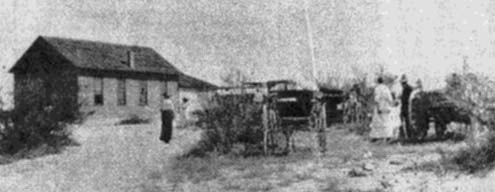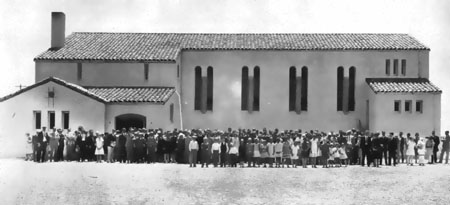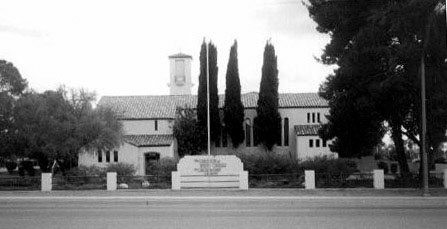History of Binghamton Ward
By
Edna Bingham Sabin
This is the history of the
first
branch of Jesus Christ of Latter-day Saints in Binghamton.
My father Nephi Bingham, my
mother
Elizabeth Dalkin Bingham and six children; Rebecca, Mae, Clara, Glen,
Floyd and
myself, Edna; moved from Casa Grande, Arizona to Tucson in the spring
of
1900. Tucson wasn’t very large at that
time. It had one street called Congress
Street, not paved, two grocery stores; Ivancovich, and Wheeler &
Perry. The dry goods stores were Rosy’s
and La Bananza and there was a watering trough for the horses.

My father located a place called
the Davidson Place north of the Rillito River that ran the year around. We lived there until the fall of 1904 when we
moved to a place south of the river called the Bayless Place, then it
was known
as the Bingham Place. There was a wagon
road leading from our home to Tucson, six miles away.
There was only one house between our house
and town. We called it the half way
house. All we could see was catclaw
bushes, sage brush, and chaparral. The
ground was crawling with rattle snakes, Gila monsters, lizards, and
tarantulas
and we had to keep our eyes on the road to keep the horses from running
away. There weren’t many Mexicans living
near Tucson. My father had to hire
Indians from an Indian village south of Tucson to help him harvest his
crops,
as he had land along the river six or seven miles from our home.
We had Mormon Church officials
and
missionaries visiting us often. On Sept
9, 1909 my father and my two older sisters, Rebecca and Mae, went to
Colonia
Dublan, Mexico to visit his nieces and nephews who were the children of
his
sister, Melvina, and her husband Winslow Farr, who had died. My two sisters stayed in Mexico to attend
college nearby. When my father returned
from Mexico his nephew, Heber Farr, and his brother-in-law, Charles
Hurst, came
with him. They looked over the Davidson
Place and decided to move to Tucson if it was agreeable with the other
ones in
Mexico. The families were agreeable and
they all began to make their plans to move to Tucson and my father
began to
make plans to have plenty of food for them when they arrived. My father’s youngest brother, Jacob Bingham,
lived near us and he made plans along with us.
My father owned a dairy and had plenty of milk.
He butchered a pig and cured it. We
had turkeys, ducks, chickens and eggs,
plenty of bottled fruit from our orchards, dried corn, beans, dill
pickles,
sauerkraut, pumpkins, five gallons of mincemeat, and a winter garden. A few days before they arrived, my father
killed a beef. He would hang it outside
at night in the cool air then take it down and wrap it in a sheet and
canvas
and lay it on a cement floor in the daytime to hold the cold in. On December 15, 1909, in the afternoon, eight
covered wagons came rolling out of the catclaw and chaparral bushed
down the
lane to our home. It was a wonderful
meeting to see them all for the first time.
They parked their wagons between our home and Uncle Jacob’s home. Some of them were very sick when they
arrived. The sick and the old people
slept in the two homes and the others slept in the covered wagons and
they all
ate their meals in the two homes and would come and go as they pleased
in the
daytime.
The people who came out of
Mexico
in the covered wagons at this time were the five Farr brothers; Heber,
Joseph,
Ernest, and their families, Wilford and Acel, not yet married. The sisters were Edith Webb and Lindy Young
and their families and Mamie Farr who was not married.
Some of the in-laws and their families also
came.
There was a small wooden
school
house near-by where all the children attended school.
The men started building their little tent
houses to use until they could build better ones. Heber
and Joe remodeled two adode houses on
their land north of the river. Most of
the people lived on the south side of the river. After
they were settled in their homes, the
land cleared of mesquite trees and their crops planted, they all
decided to dig
and build reservoirs to store the water from the river that ran the
year
round. It supplied water for all the
farms along the river.
Plans had been made earlier
with
President Joseph E. Robinson, President of the California Mission, to
visit
with us. On Saturday morning, May 21,
1910, Heber Farr and my father met the train from Salt Lake and
California to
get George Albert Smith and Joseph W. MacMurrins and President Joseph
E.
Robinson. That afternoon my father, my
mother, and my sister Clara, my two brothers Glen and Floyd, and myself
were
baptized as members of the Church of Jesus Christ of Latter Day Saints. The following Sunday afternoon, May 22, 1910,
the first Branch of the Church of Jesus Christ of Latter Day Saints was
organized, in the shade at the east of our home. The
opening prayer was given by President
Joseph E. Robinson. The new branch was
called Binghamton Branch, after my father.
There was already a little town in Arizona by the name of
Bingham. Heber Farr was ordained Branch
President,
Fredrick Granger Williams first counselor and Frank Webb second
counselor. We were all confirmed members
of the Church
of Jesus Christ of Latter Day Saints.
The sacrament was passed, talks were given, and the closing
prayer was
given by Joseph A. Farr. Church services
were held that summer under the shade trees by Heber and Joseph Farr’s
homes.
My father was county trustee
of
the Davidson school district. He
received permission to have a large school house built as more Saints
and
relatives were moving out of Mexico. By
September 1910, the school house was built and by adding the little
school
house to the south end of the new building there was room for a stage
and two
class rooms more. My father got
permission to hold church services in the school house.
At that time, the Sunday School was
organized. Joseph A. Farr was ordained
Superintendent of Sunday School, Elmer Cardon as first assistant, J.
Alma Young
as second assistant, Ellen Bluth as secretary, and Clara Bingham as
assistant
secretary. Heber O. Chlarson was set
apart as ward clerk. The next Sunday,
the ladies Relief Society was organized with Elizabeth Farr as
President and
Mae Bingham and Lindy Young as her assistants and Hazel Williams as
secretary. Later, the Primary and Mutual
was organized.
More and more people were
moving
out of Mexico but they settled near Jaynes Station by the railroad
tracks. They were clearing land for some
company. There was a school house there. There were many young people living there in
little tent houses and they would come to Binghampton to dances one
Saturday
night and we all went to Jaynes Station the next Saturday night. Some of the young boys living in Binghampton
worked for my father on the farm and milked cows. My
father furnished transportation for all of
the young people in Binghampton to get to the dances.
He had a large wagon and a hay rack on it and
two spans of mules. The boys would fill
the hay rack full of hay and stretch canvas over it and then some
quilts. My father gave the drivers a
little bell and
said “don’t whip the mules, just ring this bell and they will go fast
enough.” We had to make our own fun and
enjoyment, and we sure did, going on picnics up Sabino Canyon and
playing
Run-Sheep-Run and Twos and Threes and attending Church services.
After the land was cleared at
Jaynes Station most of the people moved to Binghampton.
Some went to Mesa, Arizona and some went to
El Paso, Texas.
When the Mormons living out of
Tucson heard that there was a branch of the Church near Tucson they
came from
Safford, Thatcher, Duncan, Pima, St. David, Douglas and Benson. Gordon Kimball came from
Safford to Tucson and worked in a bank.
Later, his brother Spencer W. Kimball (now our Prophet) came and
attended the University of Arizona. He
drove a taxi to help pay his way through school. The
Saints living in Tucson came to
Binghampton to attend Church services, dances, entertainments, and home
talent
plays.
Automobiles were being shipped
by
rail but the little dirt roads were still being used.
A few years went by, the Ft. Lowell Road was
paved to Cambell, then south to Speedway.
The people living in Tucson and Binghampton when I was married
in 1915
and left there were: Nephi Bingham and his family, the five Farr
brothers
Heber, Joseph, Earnest, Wilford, and Acel; the sisters were Edith Web
and Lindy
Young and Mamie and all their families (wives and husbands and
children) and
in-laws, Chlarsons, Clawsons, Browns, Bluths, Bilbees, Cardons (three
families), Evans, Farnsworths, Lillywhites, Hardys, Dones, Obegs,
Headers,
Jespersons, Johnsons, Paynes, Nelsons, Roleys, Stocks, Jones, Merrits,
Youngs
(three families), Winns, LeBarons, some more Johnsons, Prices,
Tompkins,
Williams, Webbs, Wheelers, some more Binghams from Mexico, Butlers and
all
their families.

At
the
dedication in 1935
In 1928, the chapel was built
on
Ft. Lowell Road. I visited over there
very often. The last time I was to
Church there was in 1965 and it had been remodeled.
There are only three members now living in
Binghampton that was present when the Church was organized. They are my brother Floyd Bingham, Milda Farr
Jones, and Thelma Young Golstine.

This
is the same Church in 2000
I have enjoyed writing this
history, but I forgot one thing. If
Fred
Sabin hadn’t come from St. David to Tucson my name would not be Edna
Bingham
Sabin.


